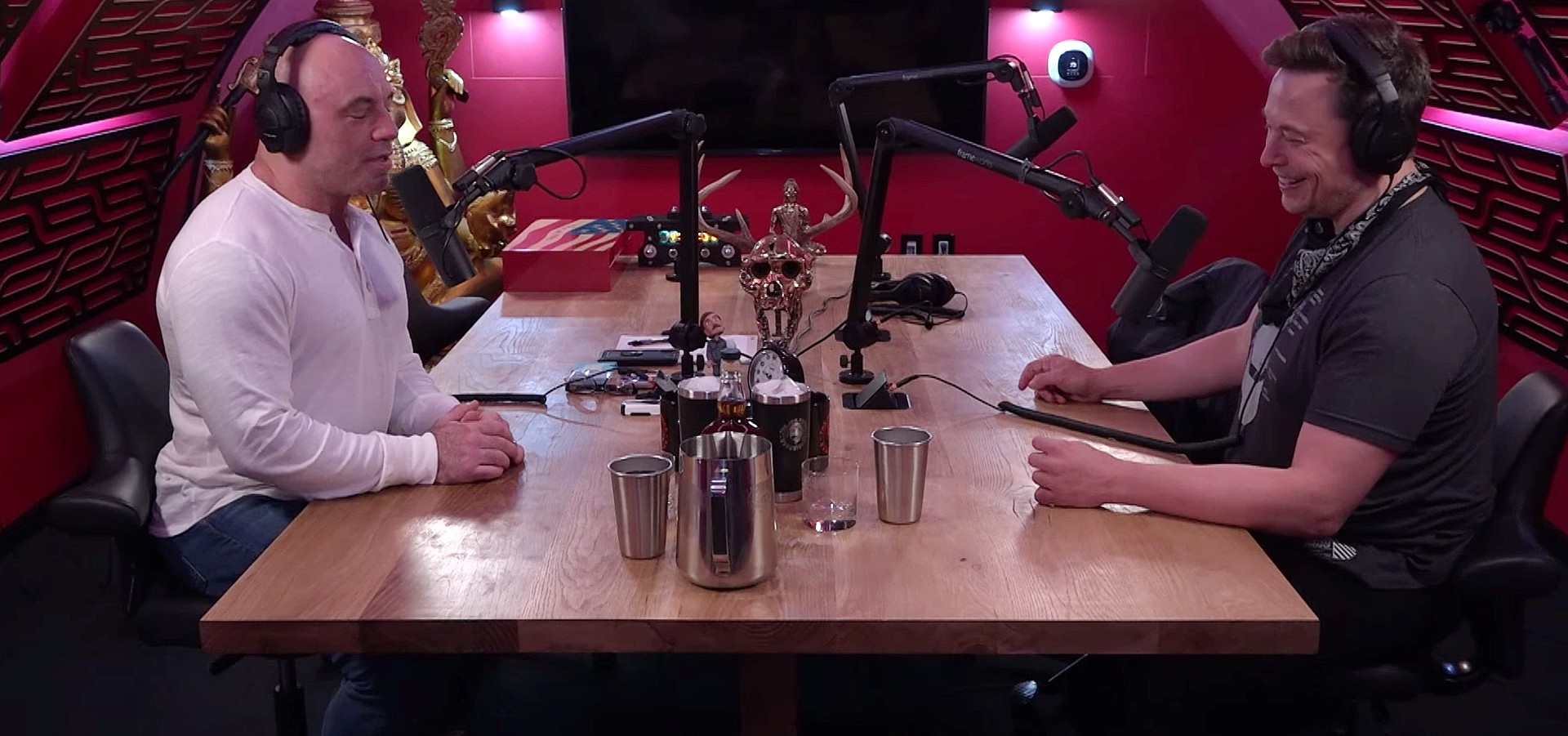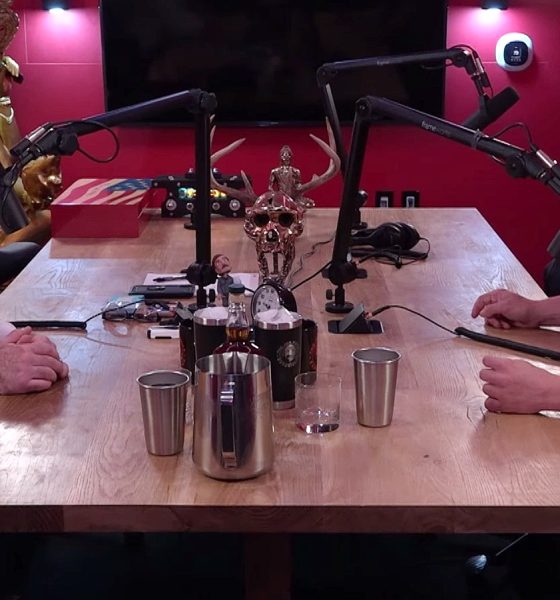

News
Elon Musk and Joe Rogan go Round 3 in new podcast interview
Tesla CEO Elon Musk joined Joe Rogan for round 3 in a new episode of the Joe Rogan Experience. The third interview between Musk and Rogan was uploaded to Spotify on Thursday.
Musk and Rogan covered a variety of topics, all of which were related to the development of the CEO’s numerous projects that are aimed toward developing sustainable energy, revolutionizing passenger transportation, and the prospect of providing humans the option of life on other planets.
In the previous episodes, Rogan and Musk talked about a wide variety of subjects, and the third appearance was no different. Rogan seemed extremely interested in getting information from Musk regarding Tesla’s upcoming product launches, including the next-gen Roadster and Cybertruck. Additionally, the two also talked about SpaceX, Starlink, and some of Musk’s other projects outside of electric vehicle development.
SpaceX
Interestingly, Rogan indicated that he has never watched a SpaceX rocket land and has relatively no knowledge of what goes into Musk’s company’s development of rockets. However, Musk did cover some tidbits related to the design and development of SpaceX rockets, including the fact that he requested Starship’s tip be pointy because of the Sasha Baron Cohen film, The Dictator.
Musk also detailed SpaceX’s mission to Rogan, along with the need to constantly retrieve data from the company’s frequent launches.
“We’re trying to make life multi-planetary. We’re trying to extend life beyond Earth. In order to do that, you have to have high tonnage to Mars. That means you need a big rocket, and you need to fly a lot.”
Tesla
Musk detailed the upcoming release of the Roadster, along with the possibility of it hovering when the car is paired with the SpaceX package. The current issue is that figuring out how to make the vehicle hover is not easy, obviously. However, Tesla may need to limit the height at which the vehicle can hover, along with the duration of time it can remain off of the ground. Safety is of utmost importance to Musk as he indicated it would be most responsible to limit the altitude and duration of time spent above the ground.
“I want it to hover. I’m trying to figure out how to make this thing hover, without, you know, killing people. I thought, maybe we could make it hover, but not too high. So maybe it could hover, like, a meter above the ground, or something. So, if you plummet, you blow out the suspension, but you’re not going to die. Maybe, I don’t know, six feet. If we put a height limit on it, it will probably be fine.”
Musk acknowledges that this may ultimately not be possible, but there will be cold-gas thrusters located behind the license plate for some of the fastest acceleration rates ever available on a vehicle.
Musk said:
“At a minimum, I’m confident we could do a thruster where the license plate flips down, James Bond-style, and there would be a rocket thruster behind it, and that gives you three tons of thrust.”
Elon Musk details Tesla Roadster hovering capability with Joe Rogan
Additionally, details regarding the Cybertruck’s design revisions were also offered by the Tesla CEO during the interview. Musk already indicated that the Cybertruck design has been finalized during the Q4 2020 Earnings Call. However, the car was subjected to size reductions of “around 3%.”
Musk said:
“That’s pretty much what it [the Cybertruck] will look like, with very small differences. You know, we adjusted the size a few percent. Like around 3% or smaller. You don’t want it to be a couple of inches too big for the tunnel.”
Production is expected to begin in limited quantities later this year, with volume production beginning “hopefully” in 2022, Musk said.
Tesla Cybertruck makes a tight squeeze through Boring Company tunnel
Musk also detailed some early design ideas that could be applied to the Tesla electric van, if it eventually becomes a produced vehicle. Musk stated during the recent Earnings Call that Tesla would likely produce one in the future. Tesla could also equip the van with solar panels due to a van’s flat and large surface area. Musk estimates that 30 additional miles of range could be given every day with the design, if it ever comes to fruition.
Musk told Rogan:
“Now, a van, because you have a big, flat area, that’s actually where solar could start to make a little more sense. You know, because you have a lot of area. You could also have, maybe, a roof where it is solar, and then, when it is stationary, [the roof] goes out and provides shade, and maybe triples your area or something like that. Now, you triple the area, and you have a big, flat surface, you could maybe start charging enough where you start getting like 30 miles a day.”
Tesla owner ‘charges’ Model 3 with homemade solar panel trailer
The full episode of Musk’s third interview with Joe Rogan is available on Spotify here.
View this post on Instagram

Elon Musk
Starlink passes 9 million active customers just weeks after hitting 8 million
The milestone highlights the accelerating growth of Starlink, which has now been adding over 20,000 new users per day.

SpaceX’s Starlink satellite internet service has continued its rapid global expansion, surpassing 9 million active customers just weeks after crossing the 8 million mark.
The milestone highlights the accelerating growth of Starlink, which has now been adding over 20,000 new users per day.
9 million customers
In a post on X, SpaceX stated that Starlink now serves over 9 million active users across 155 countries, territories, and markets. The company reached 8 million customers in early November, meaning it added roughly 1 million subscribers in under seven weeks, or about 21,275 new users on average per day.
“Starlink is connecting more than 9M active customers with high-speed internet across 155 countries, territories, and many other markets,” Starlink wrote in a post on its official X account. SpaceX President Gwynne Shotwell also celebrated the milestone on X. “A huge thank you to all of our customers and congrats to the Starlink team for such an incredible product,” she wrote.
That growth rate reflects both rising demand for broadband in underserved regions and Starlink’s expanding satellite constellation, which now includes more than 9,000 low-Earth-orbit satellites designed to deliver high-speed, low-latency internet worldwide.
Starlink’s momentum
Starlink’s momentum has been building up. SpaceX reported 4.6 million Starlink customers in December 2024, followed by 7 million by August 2025, and 8 million customers in November. Independent data also suggests Starlink usage is rising sharply, with Cloudflare reporting that global web traffic from Starlink users more than doubled in 2025, as noted in an Insider report.
Starlink’s momentum is increasingly tied to SpaceX’s broader financial outlook. Elon Musk has said the satellite network is “by far” the company’s largest revenue driver, and reports suggest SpaceX may be positioning itself for an initial public offering as soon as next year, with valuations estimated as high as $1.5 trillion. Musk has also suggested in the past that Starlink could have its own IPO in the future.
News
NVIDIA Director of Robotics: Tesla FSD v14 is the first AI to pass the “Physical Turing Test”
After testing FSD v14, Fan stated that his experience with FSD felt magical at first, but it soon started to feel like a routine.

NVIDIA Director of Robotics Jim Fan has praised Tesla’s Full Self-Driving (Supervised) v14 as the first AI to pass what he described as a “Physical Turing Test.”
After testing FSD v14, Fan stated that his experience with FSD felt magical at first, but it soon started to feel like a routine. And just like smartphones today, removing it now would “actively hurt.”
Jim Fan’s hands-on FSD v14 impressions
Fan, a leading researcher in embodied AI who is currently solving Physical AI at NVIDIA and spearheading the company’s Project GR00T initiative, noted that he actually was late to the Tesla game. He was, however, one of the first to try out FSD v14.
“I was very late to own a Tesla but among the earliest to try out FSD v14. It’s perhaps the first time I experience an AI that passes the Physical Turing Test: after a long day at work, you press a button, lay back, and couldn’t tell if a neural net or a human drove you home,” Fan wrote in a post on X.
Fan added: “Despite knowing exactly how robot learning works, I still find it magical watching the steering wheel turn by itself. First it feels surreal, next it becomes routine. Then, like the smartphone, taking it away actively hurts. This is how humanity gets rewired and glued to god-like technologies.”
The Physical Turing Test
The original Turing Test was conceived by Alan Turing in 1950, and it was aimed at determining if a machine could exhibit behavior that is equivalent to or indistinguishable from a human. By focusing on text-based conversations, the original Turing Test set a high bar for natural language processing and machine learning.
This test has been passed by today’s large language models. However, the capability to converse in a humanlike manner is a completely different challenge from performing real-world problem-solving or physical interactions. Thus, Fan introduced the Physical Turing Test, which challenges AI systems to demonstrate intelligence through physical actions.
Based on Fan’s comments, Tesla has demonstrated these intelligent physical actions with FSD v14. Elon Musk agreed with the NVIDIA executive, stating in a post on X that with FSD v14, “you can sense the sentience maturing.” Musk also praised Tesla AI, calling it the best “real-world AI” today.
News
Tesla AI team burns the Christmas midnight oil by releasing FSD v14.2.2.1
The update was released just a day after FSD v14.2.2 started rolling out to customers.

Tesla is burning the midnight oil this Christmas, with the Tesla AI team quietly rolling out Full Self-Driving (Supervised) v14.2.2.1 just a day after FSD v14.2.2 started rolling out to customers.
Tesla owner shares insights on FSD v14.2.2.1
Longtime Tesla owner and FSD tester @BLKMDL3 shared some insights following several drives with FSD v14.2.2.1 in rainy Los Angeles conditions with standing water and faded lane lines. He reported zero steering hesitation or stutter, confident lane changes, and maneuvers executed with precision that evoked the performance of Tesla’s driverless Robotaxis in Austin.
Parking performance impressed, with most spots nailed perfectly, including tight, sharp turns, in single attempts without shaky steering. One minor offset happened only due to another vehicle that was parked over the line, which FSD accommodated by a few extra inches. In rain that typically erases road markings, FSD visualized lanes and turn lines better than humans, positioning itself flawlessly when entering new streets as well.
“Took it up a dark, wet, and twisty canyon road up and down the hill tonight and it went very well as to be expected. Stayed centered in the lane, kept speed well and gives a confidence inspiring steering feel where it handles these curvy roads better than the majority of human drivers,” the Tesla owner wrote in a post on X.
Tesla’s FSD v14.2.2 update
Just a day before FSD v14.2.2.1’s release, Tesla rolled out FSD v14.2.2, which was focused on smoother real-world performance, better obstacle awareness, and precise end-of-trip routing. According to the update’s release notes, FSD v14.2.2 upgrades the vision encoder neural network with higher resolution features, enhancing detection of emergency vehicles, road obstacles, and human gestures.
New Arrival Options also allowed users to select preferred drop-off styles, such as Parking Lot, Street, Driveway, Parking Garage, or Curbside, with the navigation pin automatically adjusting to the ideal spot. Other refinements include pulling over for emergency vehicles, real-time vision-based detours for blocked roads, improved gate and debris handling, and Speed Profiles for customized driving styles.








